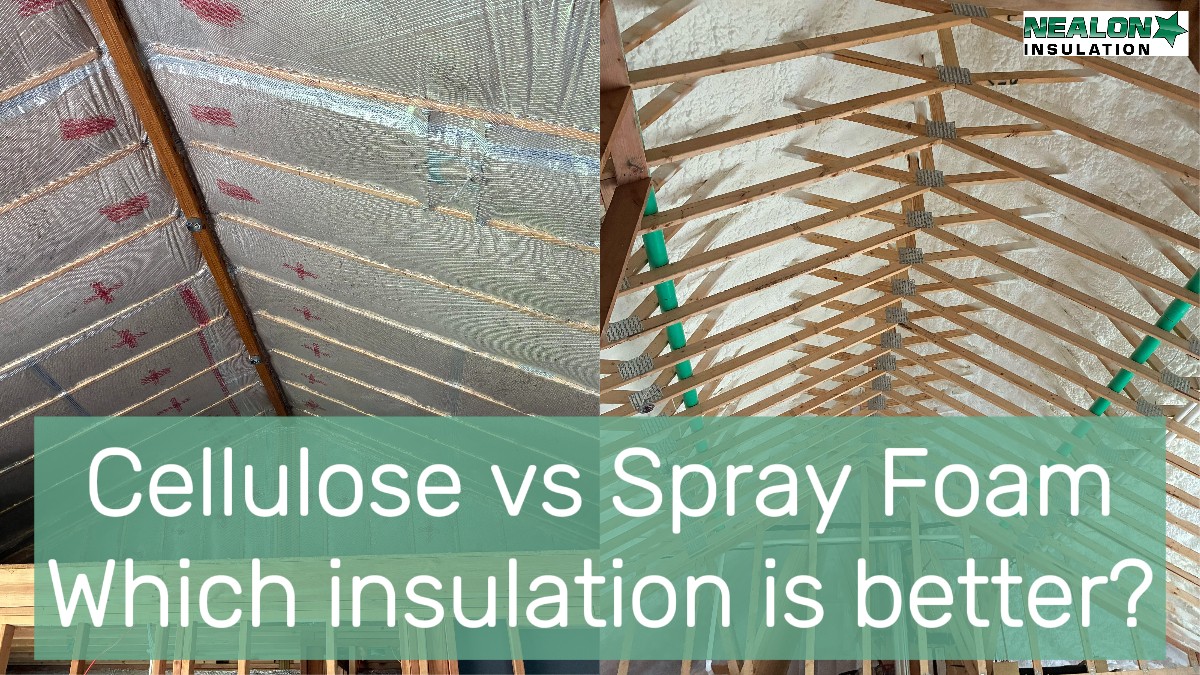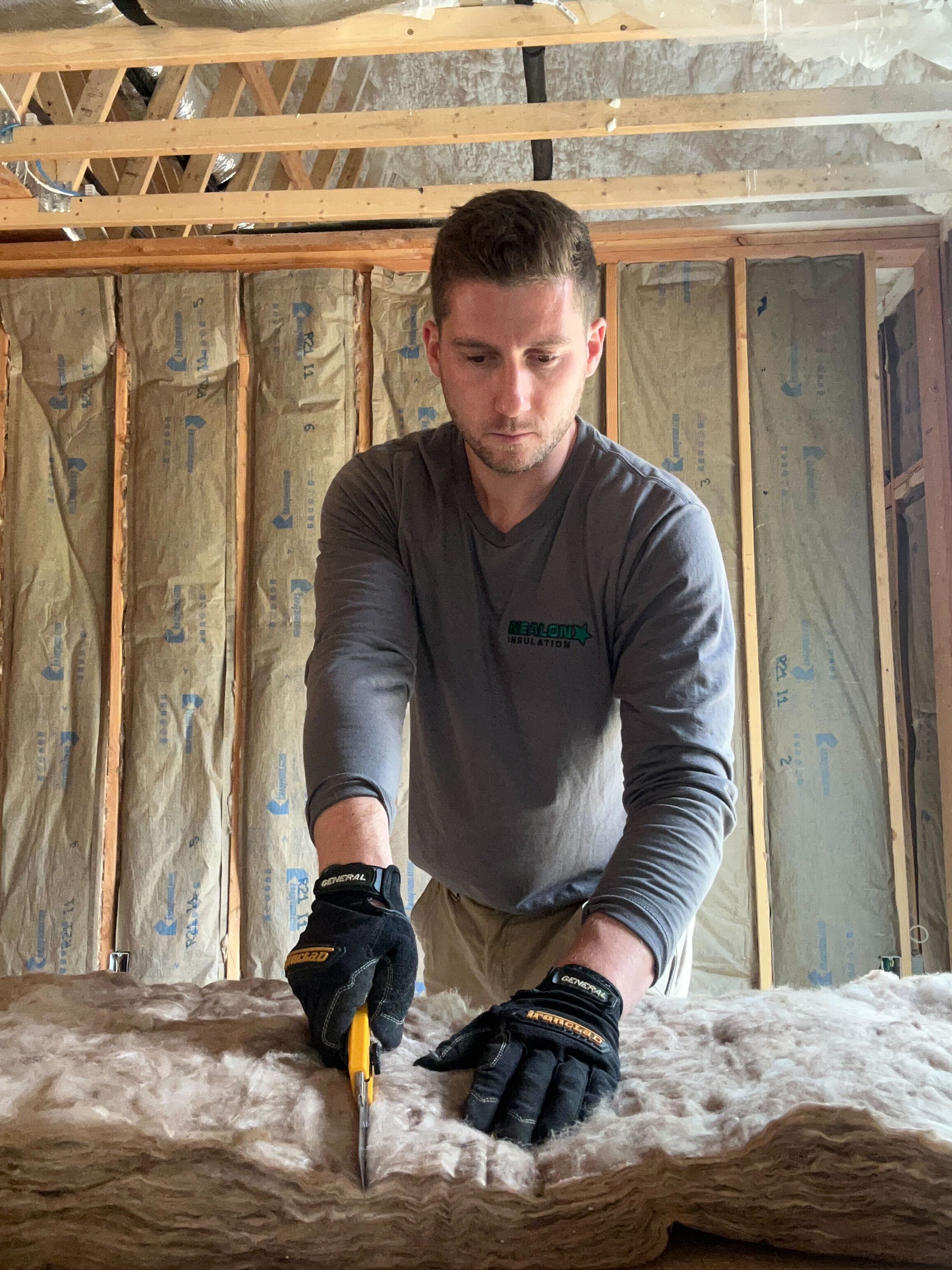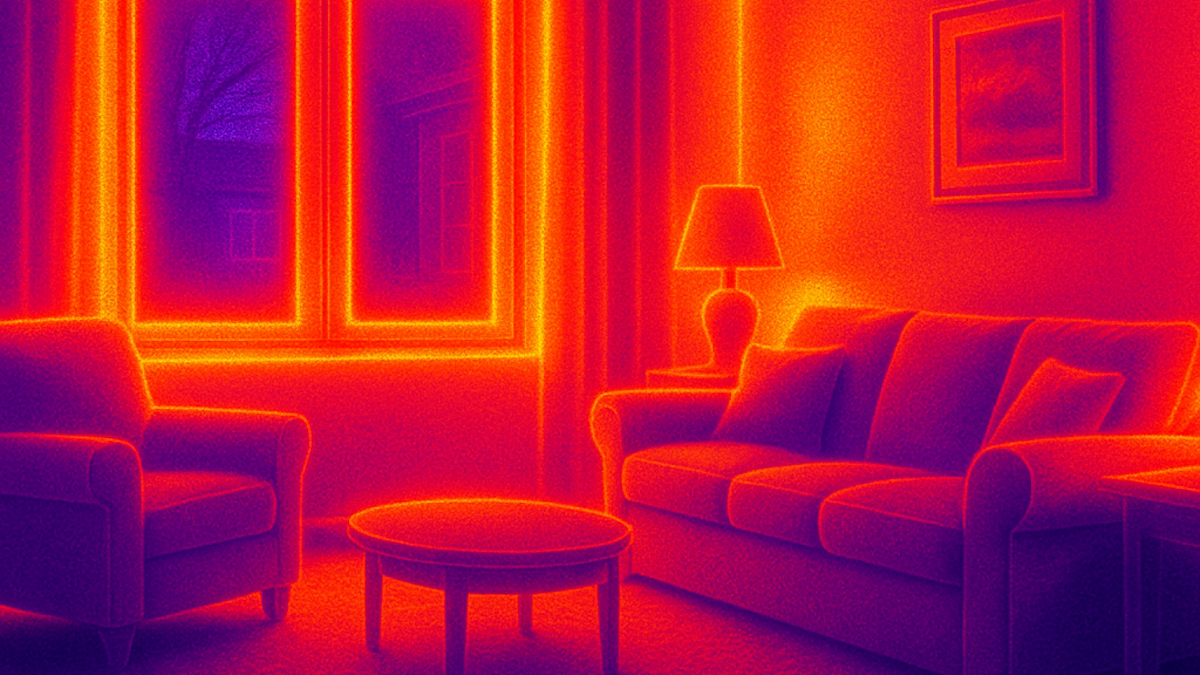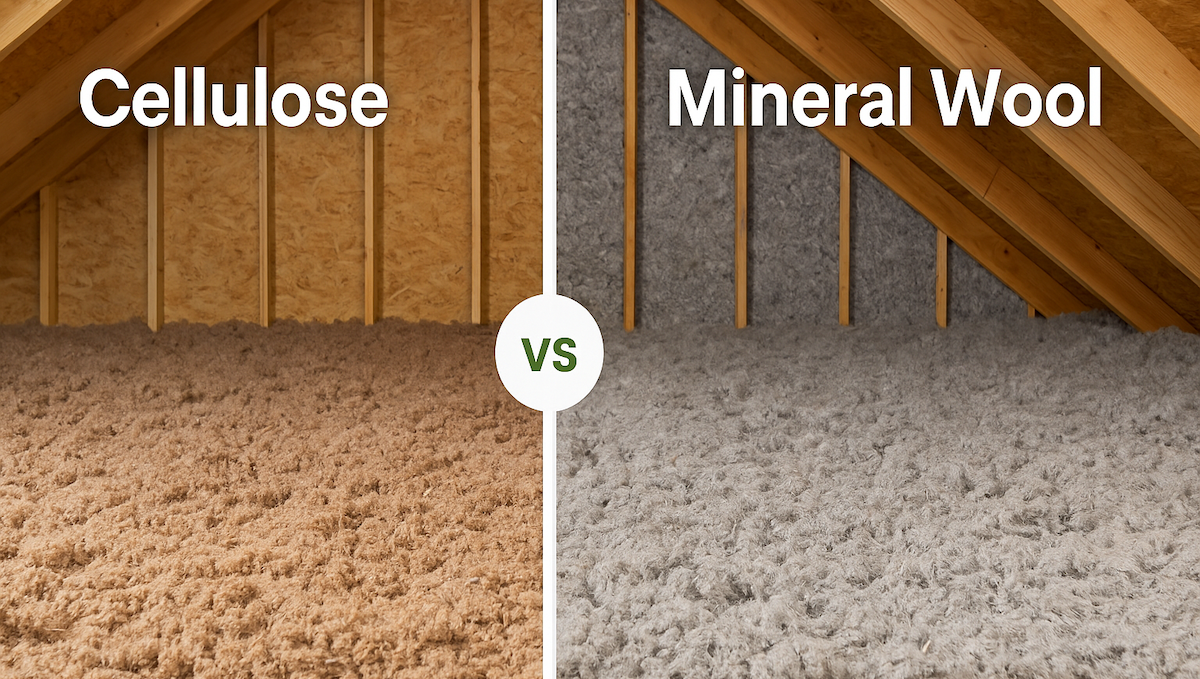Blown-In Cellulose vs Spray Foam: Which Insulation Actually Pays Off?

If you're trying to decide between blown-in cellulose and spray foam insulation, welcome to the main event. These are the two heavyweights of home insulation—and around Connecticut, folks ask us all the time: Which one should I go with?
Thing is, it’s not a one-size-fits-all answer. One’s eco-friendly and easy on the wallet. The other seals your home tighter than a mason jar—but comes with a bigger price tag. Both can be great. Both can be wrong for your house if installed poorly or in the wrong place.
In this post, I’ll break down the real difference between cellulose and spray foam insulation—what they do best, what they cost, and how to make the right call depending on your house, your goals, and your budget.
What Is Blown-In Cellulose Insulation?
Let’s start with the classic. Blown-in cellulose is made from recycled newspaper, ground up into fluffy fibers, and treated with fire-retardant borates. Think of it like dense paper snow, packed into your attic or walls. It’s been around forever, and for good reason—it works.
It’s fast to install, especially in attics. For walls, we drill small holes and dense-pack it behind siding or plaster, then patch everything up.
Pros:
- ✅ Budget-friendly
- ✅ Made from recycled materials
- ✅ Great for soundproofing
- ✅ Fast to install
Cons:
- ❌ Not an air seal on its own
- ❌ Can settle over time
- ❌ Needs a dry, ventilated space
Bottom line: Cellulose is reliable and affordable, especially for big attics and older homes. Just make sure it’s paired with proper air sealing—or you’ll still be losing heat (and money) through hidden gaps.
What Is Spray Foam Insulation?
Spray foam is the high-performance option. It’s a two-part liquid that expands into a rigid foam, sealing up cracks, gaps, and weird corners like a champ. There are two types:
- Open-cell: Softer, lighter, more affordable
- Closed-cell: Dense, rigid, vapor-resistant, higher R-value
Spray foam insulates and air seals in one shot, making it ideal for tough areas like crawlspaces, rim joists, or cathedral ceilings.
Pros:
- ✅ High R-value per inch
- ✅ Excellent air sealing
- ✅ Moisture barrier (closed-cell)
- ✅ Adds structural strength in some cases
Cons:
- ❌ 2–3x the cost of cellulose
- ❌ Requires certified installation
- ❌ Needs cure time—plan to vacate the home during install
- ❌ Not eco-friendly
Bottom line: Spray foam is a long-term investment. It costs more upfront, but it can seriously lower energy bills and fix major comfort issues.
Cost Comparison: Cellulose vs Spray Foam
Let’s talk numbers. Or use our insulation pricing calculator.
Cellulose:
- $1.25–$2.25 per sq. ft. Great for large open attics or quick retrofits.
Spray Foam:
- Open-cell: $2.00–$3.50 per sq. ft.
- Closed-cell: $3.50–$6.00+ per sq. ft.
Ideal for sealing problem areas or meeting strict energy codes.
What’s the best value?
If you’re insulating a big attic on a budget, cellulose wins hands down. If you’re air sealing a crawlspace or upgrading for performance, spray foam might be worth every penny. And if you want the best of both worlds? We often combine them—foam in tricky spots, cellulose in the big open areas.
Energy Savings
Let’s get one thing straight: insulation only saves you money if it’s installed right. Doesn’t matter what material you choose—if it leaves gaps or misses the air leaks, you’ll still be throwing cash out the window.
Cellulose does an excellent job slowing heat transfer, especially when densely packed. It keeps your warm (or cool) air where it belongs—but it won’t stop drafts on its own. When paired with air sealing, though? It’s a solid system. We regularly see 15–35% energy savings in homes that were under-insulated to begin with.
Spray Foam goes a step further. It insulates and seals in one pass, creating a tighter, more controlled indoor environment. In older homes with lots of air leakage, closed-cell foam can deliver energy savings in the 25–40% range, especially when applied in basements, rim joists, or rooflines where air leaks love to hide.
Bottom line: Both materials can cut your energy bills—the key is pairing the right insulation with proper air sealing and a smart install. That’s what turns a good idea into a real return on investment.
Moisture, Mold & Air Sealing Performance
Cellulose can absorb moisture and dry out, but it needs a well-vented attic or wall. It’s not a vapor barrier. Use vapor retarders and air sealing to keep it dry and effective.
Spray Foam, especially closed-cell, blocks moisture and vapor completely. It’s perfect for crawlspaces, rim joists, and basements where moisture is a concern.
If moisture is a big concern in your home—like in basements or unvented roofs—spray foam is the safer bet. For dry, ventilated attics? Cellulose is still a solid performer.
Soundproofing & Comfort
Cellulose is a sound-deadening champ. It’s dense and absorbs sound beautifully—perfect for bedrooms, offices, and homes near busy roads.
Spray Foam seals air leaks, which helps with comfort and some sound transfer, but it’s not as effective for full soundproofing.
If quiet is a priority, cellulose is your friend. If consistent temps and no drafts are your goal, spray foam shines.
Installation & Safety
Cellulose installs quickly and cleanly. For attics, we blow it in from the truck. For walls, we dense-pack it behind siding or plaster. Most jobs are done in a day, and you don’t have to leave the house.
Spray Foam is more involved. Crews wear full gear, and there’s off-gassing during install, so you’ll need to vacate for 12–24 hours. Once cured, it’s rock-solid and safe.
Both materials are safe when installed by pros. At Nealon, we know how to insulate without wrecking your home—or your lungs.
Pest Control
Yep—insulation can help with pests too.
Cellulose is treated with borate, a mineral that repels ants, termites, mice, and more. It doesn’t kill on contact, but it makes your attic or walls a lot less inviting.
Spray Foam doesn’t repel pests, but it seals off their entry points. Still, determined rodents can chew through it if there’s food or warmth on the other side.
Want pest control and air sealing? We sometimes combine spray foam with cellulose for double duty.
So… Which One Should You Choose?
Here’s the cheat sheet:
Go with Blown-In Cellulose if:
- You’re insulating a big attic on a budget
- You want better soundproofing
- You’re working with an older home
- You want an eco-friendly material
- You want fast installation with minimal disruption
Go with Spray Foam if:
- You need air sealing and insulation in one step
- You’re dealing with moisture-prone areas
- You want long-term energy savings
- You’re building new or doing a deep retrofit
- You’re targeting rebates or energy code compliance
Or do both.
Hybrid installs are our specialty—spray foam where it counts, cellulose where it stretches your dollar. The result? High performance without the sticker shock.
Conclusion: The Best Insulation Is the One That Fits Your House
There’s no “best insulation” in a vacuum. The real question is: what does your house need?
At Nealon Insulation, we tailor every job to the structure, the climate, and the goals. We’ve been insulating homes along the Connecticut shoreline since 1977—and we’ve seen it all. Whether it’s a 100-year-old farmhouse or a new build with modern codes, we’ll get the job done right.
Common FAQ's about Spray Foam and Cellulose Insulation
Can I add blown-in cellulose insulation over existing spray foam?
Yes, you can add blown-in cellulose over spray foam if the foam is dry, sealed, and undamaged. This is common in attics to boost R-value and soundproofing. However, ensure the added layer won’t trap moisture or block ventilation. Always consult a pro before proceeding.
How long do blown-in cellulose and spray foam insulation typically last?
Blown-in cellulose insulation lasts 20–30 years, while spray foam—especially closed-cell—can last 30 years or more. Cellulose may settle slightly over time, but dense-packing reduces this. Spray foam holds its shape better. Moisture, pests, and damage can shorten lifespan for both types.
Is spray foam insulation safe for homes with indoor air quality concerns?
Yes, spray foam insulation is safe after curing and can improve indoor air quality by sealing air leaks. During installation, chemical off-gassing requires vacating the home for 24–48 hours. Once cured, spray foam is inert. Proper installation and ventilation are critical for safety.
Can blown-in cellulose insulation help with fire resistance?
Yes, blown-in cellulose insulation improves fire resistance because it’s treated with borate fire retardants. These chemicals help slow flame spread and reduce ignition risk. While not fireproof, it adds safety compared to untreated materials. Proper installation around heat sources is essential.
How do blown-in cellulose and spray foam insulation affect home resale value?
Both blown-in cellulose and spray foam insulation can raise home resale value by boosting energy efficiency and comfort. Spray foam is viewed as a premium upgrade due to its air sealing and high R-value. Cellulose also adds value when improving outdated insulation systems.
Related Articles
Let's Work Together
Ready to transform your home into an energy-efficient haven? Schedule your free energy assessment today and experience the Nealon difference for yourself.



